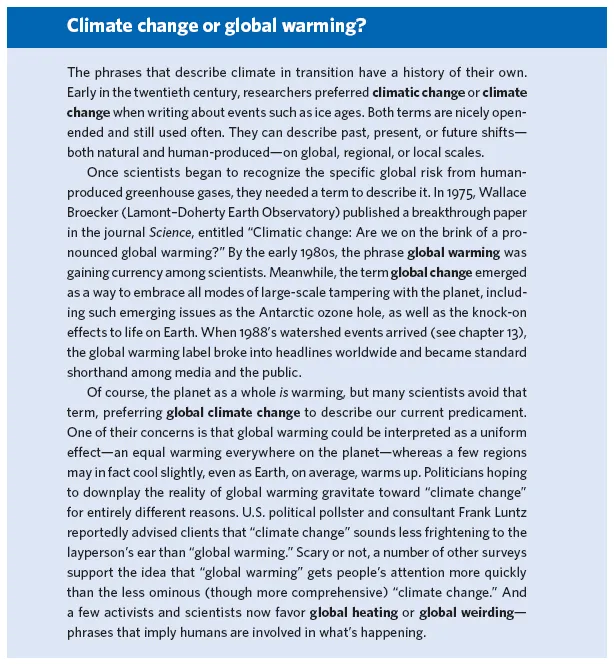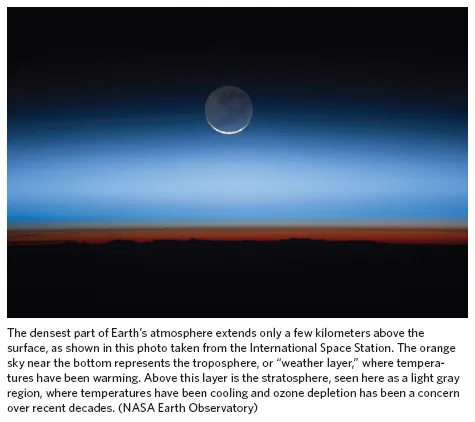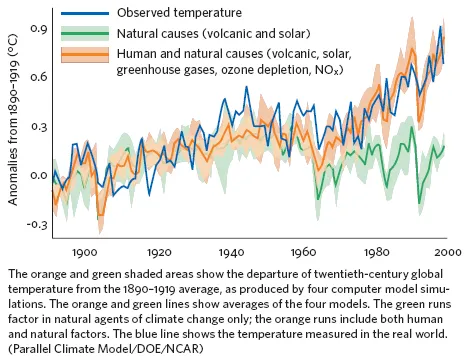![]()
1
The Basics
GLOBAL WARMING IN A NUTSHELL
![]()
CHAPTER ONE
Climate Change: A Primer
KEY QUESTIONS AND ANSWERS
Before exploring the various aspects of climate change in depth, let’s quickly answer some of the most frequently asked questions about the issue. The following pages will bring you up to speed with the current situation and the future outlook. For more information on each topic, follow the reference to the relevant chapter later in the book.
THE BIG PICTURE
Is the planet really warming up?
In a word, yes. Independent teams of scientists have laboriously combed through more than a century’s worth of temperature records (in the case of England, closer to 300 years’ worth). These analyses all point to a rise of around 0.8°C (1.4°F) in the average surface air temperature of Earth when comparing the period 2003–2012 to 1850–1900. The estimated linear trend from 1880 to 2012 is a bit higher, roughly 0.85°C (1.53°F). When the record warmth of the mid-2010s is included, the linear trend since 1880 is closer to 1°C (1.8°F). Chapter 10 explains how this average is calculated. The map on p. 4 shows how warming since the 1970s has played out regionally.
In recent decades, global surface air temperatures have spiked dramatically, reaching a new high in 1998 and similar levels in 2010. Even more striking was the series of three subsequent global record highs in 2014, 2015, and 2016. Strong El Niño events (see chapter 7) helped boost air temperatures in most of these years by releasing some of the ever-increasing amounts of heat being stored in the oceans, but it’s not as if readings were chilly in between. The first decade of the twenty-first century was the hottest on record—quite possibly warmer than any others in the past millennium (see chapter 11)—and the 2010s are on track to be warmer still.
Apart from what temperatures tell us, there’s also a wealth of physical and ecological evidence to bolster the case that Earth as a whole is warming up.
• Ice on land and at sea is melting dramatically in many areas outside of interior Antarctica and Greenland. The major glaciers remaining in Montana’s Glacier National Park could be reduced to fragments before the mid-twenty-first century. Arctic sea ice has lost nearly three-quarters of its average summer volume since 1980, and the next several decades may see a point in summer when open water covers nearly all of the Arctic Ocean, perhaps for the first time in tens of thousands of years. The warmth has been heating up international face-offs over shipping, fishing, and oil-drilling rights in parts of the Arctic once written off as inaccessible.
• The growing season has lengthened across much of the Northern Hemisphere, with a boost from urban heat islands in some areas. The average blooming date of Japan’s famed sakura (cherry blossoms) is now earlier than at any time in more than a thousand years of record keeping, pushing the traditional festivals from April to March. Daffodils in the United Kingdom’s Royal Botanic Gardens typically bloom more than two weeks sooner now than in the 1980s. In the region around Massachusetts’ Walden Pond—where Henry David Thoreau kept landmark botanical records in the 1850s—the record-setting warm spring of 2012 coaxed the highbush blueberry into flowering on the first day of April, a full six weeks earlier than in Thoreau’s time.
• Mosquitoes, birds, and other creatures are being pushed into new territories, driven to higher altitudes and latitudes by increasing warmth. Southern flying squirrels are meeting and mating with their northern relatives in Canada. Armadillos—once confined to Texas and Florida—have made their way as far north as Iowa and Indiana. Inuit in the Canadian Arctic report the arrival over the last few years of barn swallows, robins, black flies, and other previously unseen species. As we’ll see later, however, not all fauna will migrate so successfully.
• Many forms of marine life are moving poleward even more dramatically. A 2017 review found that marine-based species are heading toward the poles at an average rate of 72 km (45 mi) per decade, or about four times faster than land-based species.
But don’t many experts claim that the science is uncertain?
There is plenty of uncertainty about details in the global warming picture: exactly how much it will warm, the locations where rainfall will increase or decrease, and so forth. Some of this uncertainty is due to the complexity of the processes involved, and some of it is simply because we don’t know how individuals, corporations, and governments will change their greenhouse emissions over time. But there’s virtually unanimous agreement that global climate is already changing, that the changes pose real risk to people and ecosystems, and that fossil fuels are mainly to blame (see chapter 13).
The uncertainty that does exist has been played both ways in the political realm. Those who minimize the gravity of climate change use the remaining questions to argue for postponing action. Others point out that many facets of life require acting in the face of uncertainty—buying insurance against health or fire risks, for example.
Is a small temperature rise such a big deal?
A degree or so of warming may not sound like such a big deal, given that temperatures can vary by much more in a single day. However, little increments make a big difference when they’re in place day after day. The average annual temperature in Boston is only about 4°C (7°F) below that of Baltimore. Recent overall warming has been larger in certain locations, including the Arctic, where small changes can become amplified into bigger ones. The planet as a whole could warm by 5°C (9°F) or more by the end of this century—hardly a small rise. That’s more than half of the difference between current temperatures and the depths of the last ice age. Most of human history has unfolded within a narrow climatological window well short of such levels.
Any warming also serves as a base from which heat waves become that much worse, especially in big cities, where the heat-island effect comes into play. Like a thermodynamic echo chamber, the concrete canyons and oceans of pavement in a large urban area heat up more readily than a field or forest, and they keep cities warmer at night. During the most intense hot spells of summer, cities can be downright deadly, as evidenced by the hundreds who perished in Chicago in 1995 and the thousands who died in Paris in 2003 and Moscow in 2010 (see chapter 4).
How could humans change the whole world’s climate?
Humans have transformed Earth’s atmosphere by adding enormous quantities of carbon dioxide (CO2) and other greenhouse gases to it over the last 150 years. As their name implies, these gases warm the atmosphere, though not literally in the same way a greenhouse does. The gases absorb heat that is radiated by Earth, but they release only part of that heat to space, which results in a warmer atmosphere (see p. 27).
The amount of greenhouse gas we add to the air each year is staggering—in carbon dioxide alone, the total is more than 30 billion metric tons, or more than four metric tons per person. And that gas goes into an atmosphere that’s remarkably shallow. If you picture Earth as a soccer ball, the bulk of the atmosphere would be no thicker than a sheet of paper wrapped around that ball.
Even with these facts in mind, there’s something inherently astounding about the idea that a few gases in the air could wreak havoc around the world. However, consider this: the eruption of a single major volcano—such as Krakatoa in 1883—can throw enough material into the atmosphere to cool the global climate by more than 1°C (1.8°F) for over a year. From that perspective, it’s not so hard to understand how the millions of engines and furnaces spewing out greenhouse gases each day across the planet, year after year, could have a significant effect on climate. (If automobiles spat out chunks of charcoal every few blocks in proportion to the invisible carbon dioxide they emit, the impact would be more obvious.) Despite this, many people respond to the threat of global warming with an intuitive, almost instinctive denial.
When did we discover the issue?
Early in the twentieth century, the prevailing notion was that people could alter climates locally (for instance, by cutting down forests and plowing virgin fields) but not globally. Of course, the ice ages and other wrenching climate shifts of the past were topics of research. But few considered them an immediate threat, and hardly anyone thought humans could trigger worldwide climate change. A few pioneering thinkers saw the potential global impact of fossil fuel use (see chapter 2), but their views were typically dismissed by colleagues.
Starting in 1958, precise measurements of carbon dioxide confirmed its steady increase in the atmosphere. The first computer models of global climate in the 1960s, and more complex ones thereafter, supported the idea floated by mavericks earlier in the century: that the addition of greenhouse gases would indeed warm the climate. Finally, global temperature itself began to rise sharply in the 1980s, which helped raise the issue’s profile among the media and the public as well as among scientists.
Couldn’t the changes have natural causes?
The dramatic changes in climate we’ve seen in the past 100 years are not proof in themselves that humans are involved. As contrarians are fond of pointing out, Earth’s atmosphere has gone through countless temperature swings in its 4.54 billion years. These are the results of everything from cataclysmic volcanic eruptions to changes in solar output and cyclic variations in Earth’s orbit (see chapter 11). The existence of climate upheavals in the past raises a legitimate question: how can we be sure that the current warming isn’t “natural”—that is, caused by something other than burning fossil fuels?
That query has been tackled directly over the last couple of decades by an increasing body of research, much of it compiled and assessed by the Intergovernmental Panel on Climate Change (IPCC), a unique team that has drawn on the work of more than 1000 scientists over more than 25 years. We’ll refer often throughout this book to the IPCC’s work; see chapter 15 for more on the panel itself. As shown below, the IPCC’s second, third, fourth, and fifth assessments each issued progressively stronger statements on the likelihood of human involvement on the climate change of recent decades.
• 1995: “The balance of evidence suggests a discernible human influence on global climate.”
• 2001: “There is new and stronger evidence that most of the warming observed over the last 50 years is attributable to human activities.”
• 2007: “Human-induced warming of the climate system is widespread.”
• 2013: “It is extremely likely that human influence has been the dominant cause of the observed warming since the mid-twentieth century.”
To support claims like these, scientists call on results from two critical types of work: detection and attribution studies. Detection research is meant to establish only that an unusual change in climate has occurred. Attribution studies try to find the likelihood that particular factors, including human activities, are involved.
One way to attribute climate change to greenhouse gases is by looking at the signature of that change and comparing it to what you’d expect from non-greenhouse causes. For example, over the past several decades, Earth’s surface air temperature has warmed most strongly near the poles and at night. That pattern is consistent with the projections of computer models that incorporate rises in greenhouse gases. However, it agrees less well with the warming that might be produced by other causes, including natural variations in Earth’s temperature and solar activity. Clues like these strengthen the case that the changes we’re seeing can be chalked up to greenhouse gases.
As computer models have grown more complex, they’ve been able to incorporate more components of climate. This allows scientists to tease out the ways in which individual processes helped shape the course of the last century’s warm-up. One such study, conducted at the National Center for Atmospheric Research (NCAR), examined five different factors: volcanoes, sulfate aerosol pollution, solar activity, greenhouse gases, and ozone depletion. Each factor had a distinct influence. The eruption of Mount Pinatubo in 1991 helped cool global climate for several years. Sulfate pollution peaked in the middle of the twentieth century, between World War II and the advent of environmentalism, and it may have helped produce the slight drop in global temperatures observed from the 19...





